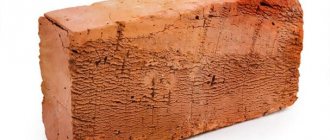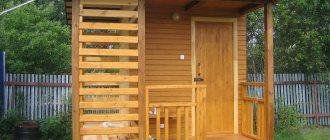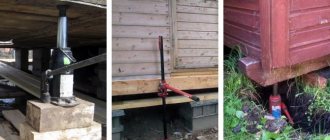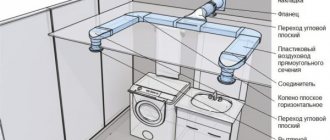Potatoes, late varieties of apples, cucumbers and tomatoes – all this can be bought in the store. Polish apples will be covered in wax, Belarusian potatoes of Egyptian origin will cost as much as chicken, and Chinese pickles - wow, I don’t even want to think about them. It’s for such cases that there is a vegetable garden. Your own tastes better and without chemicals! Was it in vain that we spent six months going to the dacha and growing all this?
All that remains is to store the harvest in your cellar. In a new plastic cellar, which we will install, abandoning the idea of building a damp basement: flooded in the spring, with mold and other joys of traditional cellars.
Purpose of the article
: provide complete information about reliable manufacturers of plastic cellars, tell about the range and features of products, indicate the price range for finished products and suggest where they can be bought.
3 steps to choosing a plastic cellar
| 1. Select volume | |
| 3.5-5 m³ |
Ideal for: dacha, if you need to put 5 bags of potatoes, a box of apples, up to 100 pcs. 3 l. cans of seaming. |
| 5-8 m³ |
Ideal for: a large family of 5-8 people, who prepared up to 200 three-liter jars of seaming, a dozen bags of potatoes and a couple of boxes of apples for the winter. |
| more than 10 m³ |
Ideal for: for collective use, for example, 2-3 families. |
| 2. Select a location | |
| in an open area (without a canopy) |
Ideal for: cases when you need a full-fledged basement-type room with a safe descent. Convenient to bring in groceries. |
| under a canopy |
Ideal for: installation on a site next to a private house, subject to permanent residence. |
| under the house or garage |
Ideal for: active use of the cellar in a private house, when they go down to buy groceries once a week or more often. |
| 3. Choose a material | |
| polypropylene (PP) |
Ideal for: installations in complex heaving soils, when there is a risk of crushing the container under pressure from frozen soil. |
| polyethylene (PE) |
Ideal for: installations in prepared reinforced concrete sarcophagi or in sandy soils, where there is no risk of compression of the cellar. |
As for the configuration, the most common option includes a container with two pipes with a diameter of 110 mm for natural supply and exhaust ventilation, 2-3 rows of shelves around the perimeter, a ladder made of plastic, metal or wood, a hatch or door, and lighting. The manufacturer can also install a thermometer-hygrometer, but it is not a problem to purchase it yourself - the presence of this device in the kit should not greatly affect the final cost.
Additionally, it is possible to decorate the walls with lining, strengthen the structure with reinforcement, and insulate it.
Note:
To make the comparison of prices for cellars from different manufacturers more clear, we evaluated models with dimensions equal to or close to 2000 × 2000 × 2000 mm (L × W × H), i.e. volume about 8 m³.
Summary table with manufacturers
| Company | Production Features | Minimum price |
| 1. LLC "Plastmaster" |
Ideal for: someone whose plot is located near the Moscow or St. Petersburg Ring Road, and who needs a non-standard size cellar. | from 98900 rub. for a cellar 2000×2000×2000 mm made of 10 mm thick PP |
| 2. LLC "Ekaterinburg Plant of Polyethylene Products" |
Ideal for: residents of the Sverdlovsk region due to the close location of the plant and affordable price. Suitable for those who only need a sealed container for the cellar - without shelves or stairs. It will last a long time if installed in non-heaving soil. | from 64650 rub. for a PE container with a height and diameter of 2.3 m, with a wall thickness of 21-23 mm. |
| 3. Ecohydrostroy LLC, Atlant |
Ideal for: those who need a complete cellar set with a 3-year manufacturer's warranty, as well as those for whom the classic design with an entrance from above and a steep staircase is not suitable. | from 121,000 rub. for a round cellar with a diameter and height of 2 m, made of 10 mm thick PP. |
| 4. Expokom LLC, Titan |
Ideal for: elderly people due to the availability of models with a convenient descent. Or for situations when you need a model with a dedicated entrance group. | from 156900 rub. for a cellar 2000×2000×2000 mm made of PP with a thickness of 10-15 mm |
| 5. LLC "Mechanics", Tingard |
Ideal for: residents of the Vologda region and those who need a cellar with a volume of about 8 m³. | from 167,000 rub. for a cellar 1900×1900×2100 made of PE up to 15 mm thick |
| 6. LLC PA "Topol Eco" |
Ideal for: those who need a small fully equipped cellar, which can be buried right on the site, without fear that it will be compressed by heaving soil. | from 144900 rub. for a cellar 1660×1500×2500 mm made of 8 mm thick PP |
| 7. Aqua Hold LLC, Bars |
Ideal for: those who need a reinforced structure for complex heaving soils. Fans of finishing with valuable wood species will appreciate the older Bars models. | from 186,300 rub. for a cellar 2000×2000×2300 mm made of 8 mm thick PP |
| 8. Alta Group, Alta Pogreb |
Ideal for: those who need a container for a cellar, which can be completed with minimal modifications. | from 149900 rub. for the cellar 2160×2160×2160 mm made of 8 mm thick PP |
LLC "Plastmaster"
Plastmaster LLC specializes in the production of polypropylene (PP) and low-density polyethylene (HDPE) sheets, as well as products made from them. The product catalog includes plastic grease traps, septic tanks, swimming pools, swimming pools and cellars. Production is located in Moscow and St. Petersburg, the main warehouse is in Dolgoprudny, not far from the Moscow Ring Road.
Product Features
Cellars are made from polypropylene sheets with a thickness of 10, 12 or 15 mm - depending on the size of the container. The larger it is, the more demanding the rigidity criterion, and the greater the thickness of the material. To strengthen the structure, stiffening ribs are provided.
The cross-section of the cellar can be square, rectangular or round. There is no need to adhere to the size chart, they will be assembled according to your sizes. The same applies to the number and placement of shelves.
Models from Plastmaster LLC
| Name | Economy | Standard | Premium | Premium Plus |
| Equipment | The kit includes ventilation: 2 pipes for natural air circulation - and a manhole cover. The price does not include a ladder, shelves, or lighting. | The set includes ventilation, a hatch cover, 3 rows of shelves around the perimeter, an extension ladder, and a lampshade for lighting. | ||
| Size, L×W×H, mm | 2000×2000×2000 | |||
| Wall thickness, mm | 10 mm | |||
| price, rub. | 98900 | 118700 | 117500 | 141000 |
Conclusion:
products from Plastmaster are suitable for those who have a dacha or a private house near Moscow or St. Petersburg. Otherwise, delivery and installation will cost a pretty penny. The main feature of the manufacturer: the guys can make a cellar of any size, even as a warehouse in case of nuclear war. A large cellar will be delivered in parts and assembled on site.
How to install
Owners of private houses or cottages, when purchasing a cellar, are subsequently faced with the problem of installing it. Beginners have virtually no idea how to properly install a structure underground. Lack of knowledge leads to the fact that groundwater pushes the container to the surface or a leak occurs. In order to avoid unpleasant consequences of future use of the product, it is necessary to understand the nuances of installation and take the work seriously. To install the “box” with your own hands, it is recommended to write down an action plan and a set of necessary tools on a piece of paper. Installation of a plastic structure is easier compared to a conventional cellar. The work consists of four stages.
Preparing the pit and base
It is worth measuring the dimensions of the structure and marking the parameters at the selected location. There are two ways to dig a hole: manually or using construction equipment. If you work alone with a shovel, it will take several days. In addition, this method requires endurance. If you decide to dig a hole yourself, you will need accessories for excavation work: a shovel and a regular shovel. To quickly solve this problem, an excavator or front loader is suitable. You should additionally take care of the availability of a truck crane, since without it you cannot cope with laying heavy slabs on the bottom of the pit.
If concrete mixture is being poured, then you need to find a machine - a mixer. Using technology will save energy and time. Difficulties mainly arise when it is necessary to dig a pit of the required size under any building. In order not to encounter a typical problem, a good option would be to choose a place for a cellar in advance, before starting country house construction, or to place it separately, without connecting it with future buildings. It is imperative to lay concrete slabs on the base of the pit or fill it with ready-made mortar. If groundwater is located close to the foundation, install slabs at the bottom of the dug hole.
Isolation of the site from groundwater ingress
The composition of the caisson is made of plastic, so moisture will not affect the quality of the item. For a site located in the lower areas of the earth, more material for the foundation will be required, since the lack of mass will lead to the container being pushed upward. To be sure that the cellar is fixed, you need to install a concrete slab inside the chamber on the floor covering. The gravity of the material provides pressure on the floor, which holds the “box” in place.
Additional insulation
Manufacturers guarantee that there is no need to insulate the cellar. However, practice shows the opposite. Experienced owners of the caisson have noticed that during use of the product, the maintenance of a certain temperature is disrupted. This is due to the fact that the structures are located in different regions where the weather varies. For example, in the Krasnodar Territory it is warm, but in Siberia in winter the frosts are down to -30 degrees. The insulation method should be used if the temperature in the area changes due to changing seasons.
Ventilation
Each cellar is equipped with a ventilation system. This is a set of pipes that extend slightly to the surface of the container. The task is to maintain the microclimate in the cabin. A breakdown occurs if the owner wants to change any settings in the operation. Experts do not recommend repairing ventilation yourself, since such intervention can damage the system. If the functioning of the structure is disrupted, you should contact the company where the product was purchased under warranty or call a repairman.
LLC "Ekaterinburg Plant of Polyethylene Products" (Cellar)
LLC "Ekaterinburg Plant of Polyethylene Products" produces goods from polyethylene. The range includes water containers, septic tanks, furniture, caissons, cellars and other products for the manufacture of which plastic can be used.
Production is located in the Urals, but the company has representative offices in Moscow and St. Petersburg
Product Features
The plant offers 2 models of cellars: spherical and cylindrical. In both, the entrance is provided from above, through the neck. The containers are made of food-grade plastic, inside there is a layer of foamed polyethylene for additional thermal insulation.
Models from Ekaterinburg Polyethylene Products Plant LLC
| Name | Cellar 5 | Cellar 10 |
| Equipment | Container with supply and exhaust ventilation, neck and hatch with a lid. | |
| Size, L×D or H×D, mm | 2300×2300 | 2900×2300 |
| Wall thickness, mm | 21-23 | 23-25 |
| price, rub. | 64650 | 117850 |
Conclusion:
Despite the fact that the company offers only 2 models, in terms of their volume they can be used both as a country house option and as a solution for a private home with a family of 5 or more people. Of course, if the consumer is satisfied with the classic design with an entrance from above and a descent along a steep staircase. You should also take into account that the standard package does not include shelves and a ladder - they will have to be purchased separately.
Where can I buy
Popular models can be purchased from manufacturers or dealers, where the best new products are presented. There you can study the characteristics in detail, compare parameters, look and touch them with your hands. Consultants will explain in detail and give valuable advice - what they are, how to choose, how much it costs.
In addition, the required product can be ordered online in the online store or on the pages of the Yandex.Market aggregator. Before ordering, be sure to read the description, look at photos and diagrams of installation and installation instructions, as well as user reviews.
Ecogidrostroy LLC (Atlant)
is located in the Moscow region, in the city of Lobnya. The company specializes in the production of products from polypropylene sheets. These are mainly septic tanks, caissons, cellars and other plastic containers of various capacities.
Product Features
The cellars are produced under the Atlant brand. A total of 5 lines are available:
- rectangular with a hatch at the top;
- round (cylindrical) with an entrance at the top;
- rectangular with horizontal entrance;
- rectangular with a side vertical entrance;
- rectangular with side entrance at an angle of 45°
PP sheets are sewn together using extrusion welding. Therefore, the size of the cellar can be any. The thickness of the sheets is 10-15 mm, the specific value depends on the size of the structure. For cellars in which one side is more than 4 m, a material with a thickness of 15 mm is used, for all others - 10 mm.
The strength of the structure is ensured by a developed external system of stiffening ribs with a pitch of no more than 25 cm. For models with a round cross-section, metal stiffening belts are used. All cellars of this manufacturer have a reinforced reinforced bottom.
Models from Ecohydrostroy LLC
| Name | Rectangular Atlant 2000×2000×2000 | Round Atlant 2000×2000 | Rectangular Atlas with horizontal entrance 2000×2000×2000 |
| Equipment | Extension ladder made of thermowood, shelves made of moisture-resistant plywood in 3 levels around the perimeter, supply and exhaust ventilation, electricity supply, lighting. | The same, but instead of an extension, there is a flat stationary staircase with railings, a door made of PP. | |
| Size, L×W×H or H×D, mm | 2000×2000×2000 | 2000×2000 | 2000×2000×2000 |
| Wall thickness, mm | 10 | ||
| price, rub. | 156900 | 121000 | 255000 |
Conclusion:
products from Ecogidrostroy LLC will appeal to those who are looking for a non-standard solution for constructing a cellar with various entrance options. Due to the rigid reinforced structure, such containers can be used on any soil.
Plastic cellar for a summer residence: reviews from owners
Most owner reviews are positive, and almost all users of such structures note that their price is completely justified and is fully compensated by ease of use.
At the same time, many note that if the ventilation regime is violated or improperly installed, the storage facility loses its basic properties - tightness, moisture resistance and the ability to maintain a stable temperature regime.
Note: For example, if the bottom of the pit and the caisson floor are not sufficiently strengthened, nearby groundwater can simply push the cellar to the surface.
There is also a fairly widespread opinion that, contrary to manufacturers’ assurances about the stability of the temperature inside, this indicator should still be controlled independently. This is explained by the fact that all models are manufactured using the same technology, and temperature control directly depends on the climatic characteristics of the region. Therefore, it is recommended to carry out additional thermal insulation or order a turnkey installation.
Expokom LLC (Titan)
The production and exhibition site of Expokom LLC is located in Moscow. The company works with polypropylene sheets and produces septic tanks, fonts, caissons, containers, grease traps, ventilation shafts and cellars. The company also offers the production of non-standard plastic products according to customer drawings.
Product Features
Expokom LLC produces cellars under the Titan brand. Total 9 modifications:
- Classic. Rectangular cellar with sliding wooden staircase and hatch at the top;
- Agronomist. Same as Classic, but with a flatter staircase. The model is adapted for elderly people;
- Agronomist 2. Same as Agronomist, but with a vertical entrance. Such a cellar can be installed not under a building, but in a free area, without the need for a canopy;
- Farmer. The model with the shallowest staircase has an insulated plastic door;
- Farmer 2. Same as Farmer, but adapted for use in open spaces, has a developed entrance group;
- Summer resident. Used as an underground extension to a country house;
- Summer Resident 2. Modified version of Summer Resident with an enlarged entrance area;
- Gardener. Compact model with an insulated plastic door for cutting into a hill on the site;
- Round. With wooden shelves in 3 rows and an extension ladder.
The bottom of all cellars from Expokom LLC is made with reinforcement, the walls have powerful plastic stiffeners.
Models from Expokom LLC
| Name | Titan Classic | Titan Farmer | Titan Summer Resident |
| Equipment | Hatch with a cover, supply and exhaust ventilation, 3 rows of PP shelves around the perimeter, electrical cable entry, folding wooden ladder, temperature and humidity sensor, lamp. | ||
| Size, L×W×H, mm | 2000×2000×2000 | ||
| Wall thickness, mm | 10-15 | ||
| price, rub. | 156900 | 256000 | 241900 |
Conclusion:
Expocom offers a huge selection of models to suit every taste. The cellars are equipped with everything necessary for full use. However, prices are higher than average, especially if we consider purchasing in cities far from Moscow and the Moscow region.
External drainage
Along the entire perimeter of the future structure, it is necessary to dig drainage trenches about 40 cm wide, preferably 20-30 cm below the proposed base.
It is necessary to dig trenches at a slight slope so that the water drains faster, and to make digging easier and the bottom does not wash away, you need to dig so that the shovel goes towards the flow of water.
Then, at the bottom of the trench, a compacted sand cushion is created, which is covered with geotextile to prevent mixing of layers.
It is important to remember that some inexpensive types of geotextiles conduct water in only one direction, which must coincide with the direction of water flow in the trenches. Larger drainage material in the form of pebbles, expanded clay or crushed stone is laid on top of the geotextile. Larger drainage material in the form of pebbles, expanded clay or crushed stone is laid on top of the geotextile
Larger drainage material in the form of pebbles, expanded clay or crushed stone is laid on top of the geotextile.
Special drainage pipes made of asbestos or polymers, equipped with holes on top or on all sides, are laid in prepared trenches and connected into a single system.
If there is too much groundwater, then it is likely that at the place of its main exit from the drainage pipe system it is necessary to dig a special reservoir into which it will flow during a flood or after rains, and then seep out of it back into the ground.
The storage tank will also have to be protected from the soil sliding with geotextiles, concrete walls or a large plastic container.
When filling drainage trenches with pipes, the operation is repeated: first sand, then geotextiles, then gravel.
The area under the bottom of the cellar is leveled with gravel. The advantage of external drainage is that it removes water before it reaches the structure, but requires a little more excavation.
LLC "Mechanics" (Tingard)
The production of Mechanics LLC is located in the Vologda region, in Cherepovets. Unlike other manufacturers presented in our review, this company produces only plastic cellars. Food grade polyethylene is used as a raw material.
Product Features
The cellars are produced under the Tingard brand. They are made using seamless technology from PE with a thickness of up to 15 mm. The design is based on a metal profile frame. It is also the basis for attaching the shelves. The ribbed structure of the walls, floor and ceiling provides additional rigidity to the structure.
There are 4 models in total, differing in size. 3 out of 4 cellars have an entrance from above. Descent is carried out using a ladder. The largest model is equipped with a stationary, flatter staircase.
Models from LLC "Mechanika"
| Name | Tingard 1500 | Tingard 1900 | Tingard 1900-B |
| Equipment | Metal ladder, manhole cover, wooden flooring, supply and exhaust ventilation, weather station, autonomous LED lighting, 3-level shelves on 3 walls. | ||
| Size, L×W×H, mm | 1500×1500×1900 | 1900×1900×2100 | 1900×1900×2100 |
| Wall thickness, mm | up to 15 | ||
| price, rub. | 110 | 167000 | 189000 |
Unlike others, marketers at Mechanics LLC do not eat their bread in vain. On YouTube you can find many videos mentioning Tingard cellars. For example, this commercial clearly demonstrates the device of a popular model.
Conclusion:
Despite the meager assortment, Tingard cellars are distinguished by the use of seamless technology, which should have a positive effect on the tightness of the cellar. Contrary to the assertion that most polyethylene containers are not rigid enough, Tingard compensates for this deficiency with a strong internal frame and a developed ribbed surface of the cellar.
What it is
A plastic cellar is a sealed container made of food-grade polyethylene or propylene that maintains a comfortable microclimate inside at any time of the year.
Designed for long-term storage:
- food and beverages;
- homemade preparations, pickles and canned food;
- vegetables and fruits;
- tools or technical equipment.
The principle of operation is similar to an airtight tray in the refrigerator for storing food.
LLC PO "Topol Eco" (Topol-ECO)
Topol Eco Group of Companies was repeatedly mentioned in our reviews. This is one of the leading Russian manufacturers of wastewater treatment plants. The main material for the cases is PP sheets. The assortment also includes plastic cellars that look like stations, because both groups of goods are assembled using the same technology.
The plant is located in the Moscow region, in the city of Lobnya. Products are sold through dealers throughout Russia.
Product Features
The manufacturer offers one model in 4 sizes, diluting the line with modifications with an extended neck. A total of 8 cellars with a useful volume from 4 to 9.2 m3. Everything is made of PP, even the comfortable step ladder with wide steps and anti-slip pads.
The body is made in the form of a honeycomb with a thickness of 80 mm, which gives the structure great strength. This approach has proven itself in the production of high-capacity VOC Topol.
Models from Topol Eco
| Name | Cellar PP 1 | Cellar PP 3 | Cellar PP 4 |
| Equipment | Manhole cover, 3 rows of plastic shelves along 2 walls, plastic ladder, supply and exhaust ventilation, moisture-proof electrical connections, interior lighting, thermometer-hygrometer. | ||
| Size, L×W×H, mm | 1660×1500×2500 | 2160×2000×2500 | 2660×2000×2500 |
| Wall thickness, mm | 8 mm | ||
| price, rub. | 144900 | 201700 | 227200 |
Watch the 3.5 minute commercial. It clearly shows the cellar with all the technical nuances. You will see not only the structure of the shelves, stairs and hatch, but also appreciate the volume of bins, which is invisible in most photos.
Conclusion:
Despite the small thickness of the polypropylene sheets used, cellars from Topol Eco are distinguished by a large margin of safety; they are not compressed even by very heaving soil. However, the high cost and uniformity of the models leave their mark: such a cellar is suitable for those who are looking for a classic model without an improved entrance group, and for whom the presented sizes of plastic containers are suitable. It should also be taken into account that the manufacturer places shelves only along 2 walls, which significantly reduces the number of cans with seams placed in it.
Another way to build a cellar on high groundwater
Technology for constructing a waterproof prefabricated concrete cellar.
- After the water leaves the area, dig a pit of the required depth. It should be noted that when moving down more than two meters, it is necessary to install formwork to strengthen its walls. It is necessary even if the soil is clayey. Unexpected collapses often occur on wet soils.
- Having reached the desired depth point, they begin to level the bottom of the cellar.
- After which waterproofing material is laid. You can use roofing material folded in several layers or dense polyethylene.
- Then sand and gravel filling is carried out. The first layer should be 5-10 cm, the second – 10-15 cm. Both sand and crushed stone need to be leveled and compacted.
- The formwork is completed to the top of the pit and all its walls are covered with sheets of polyethylene or roofing felt, which should overlap each other by at least 10 cm. It is best to lay the roofing felt clockwise, as this will make pouring concrete easier.
- Next to the first walls holding the soil, internal formwork is installed and also lined with waterproofing material from the inside. 10 cm is a sufficient width between the panels of a wooden frame. Initially, the internal formwork is made of small height to make it more convenient to pour the mortar and lay the reinforcing material.
- Then the walls of the cellar are concreted: the prepared cement-sand mortar is poured into the opening between the walls of the formwork. Its proportions are as follows: 1 part M400 cement and 3 parts sand. To increase the strength of concrete, reinforcing mesh is placed inside the formwork. It is made of reinforcement with a diameter of 12 mm and a mesh of 15/20 cm.
- Filling is done layer by layer and in a circle. In this case, the concrete will press the roofing felt sheets, and the waterproofing of the cellar walls will be of high quality.
- After the previous layer has set, the formwork is expanded, new pieces of reinforcing mesh are lowered and pouring continues.
- After completion of the work, the formwork is dismantled in 7-8 days.
After this, they begin concreting the bottom of the cellar. It also needs to be reinforced with a mesh of metal rods. This work is simpler than building cellar walls and will not cause any difficulties. After the concrete has matured, the bottom of the cellar must be coated with rubber-containing mastic.
https://youtube.com/watch?v=Ui1qzbuWHrU
If there is no drainage system on the site, you can use this method of draining water from the pit: dig a drainage well near it so that its depth is below the bottom of the cellar. And connect these two depressions in the ground with a drainage pipe. After which a pump is installed, which is turned on as needed. Such a cellar will always be dry and will last for many years.
Aqua Hold LLC (Bars)
Aqua Hold LLC produces polypropylene products: septic tanks, caissons, swimming pools, swimming pools, cellars, etc. We have written about them and their products more than once, for example, here. Production is located in the Moscow region, in Zhitnevo.
Product Features
The plant supplies cellars under the Bars brand. 3 lines available:
- Economy Only the shelves are covered with wood; the stairs do not have handrails.
- Classic. With wood trim on shelves and walls. The staircase has a handrail.
- Premium. With walls and shelves finished in oak or thermo-ash, stairs with handrails.
The width of the products is 2 m, the height is 2.3 m. The length can be varied from 2 to 4 m in increments of 0.5 m. If necessary, the company is ready to manufacture a cellar according to the customer’s drawings. There is also a service for assembling a cellar indoors. This will cost 25% more than the usual solution.
The design of the basic models is reinforced not only with stiffening ribs, but also with reinforcement with a diameter of 12 mm embedded in the walls of the tank.
Models from Aqua Hold
| Name | Bars Economy | Bars Classic | Bars Premium |
| Equipment | Extension wooden ladder, preparation for strengthening the roof and floor, 3 rows of shelves around the perimeter, lighting, ventilation, thermometer-hygrometer. | ||
| Size, L×W×H, mm | 2000×2000×2300 | ||
| Wall thickness, mm | 8 | ||
| price, rub. | 186300 | 212000 | 298000 |
The one-minute video below demonstrates the technology for installing such a cellar - it’s simple!
Conclusion:
It is advisable to buy Leopard for installation in areas with difficult soil, because For normal conditions, such a cellar is overly reinforced and too expensive.
Features of use
Ready-made plastic structures combine the main advantages of sealed caissons, which fully compensate for certain disadvantages.
Advantages:
- quick construction and arrangement of the premises without the need for additional work with significant savings in time and installation costs;
- universal use for any climatic and engineering-geological conditions;
- various installations - above ground, semi-buried, underground, incl. under buildings or structures;
- moisture resistance;
- ability to withstand temperature changes;
- chemical neutrality, does not absorb odors and there are no harmful fumes;
- reliable protection against insects and rodents;
- simple operation and maintenance with long-term preservation of aesthetic appearance;
- resistance to rotting and corrosion;
- long service life up to 50 years.
Flaws:
- overcharge;
- standardization of the dimensions of the finished product, which complicates installation in built-up areas;
- the need to strictly adhere to operating rules and use of a special fastening system at high groundwater levels.
Alta Group (Alta Pogreb)
The Alta Group plant is located in the Moscow region, in Chekhov. It is equipped with casting, cutting, welding and extrusion machines. The company specializes in the production of VOCs, grease and sand traps, pumping stations, caissons, collectors, cellars, etc. – a total of 12 product lines.
Product Features
The catalog of cellars is presented in 4 models, which differ only in size. The container is made of PP sheets with V-shaped stiffeners welded on the sides and on the roof. This is enough to prevent compression on sandy and loamy soils.
The entrance to the room is from above, through the hatch. The basic configuration does not include a ladder or shelves, but there is a base for installing the latter.
Models from Alta Group
| Name | Alta Pogreb 20 | Alta Pogreb 25 | Alta Pogreb 30 |
| Equipment | Lid without insulation, shelf inserts, supply and exhaust ventilation*. | ||
| Size, L×W×H, mm | 2160×2160×2160 | 2660×2160×1970 | 3160×2160×2080 |
| Wall thickness, mm | 8 | 10 | 12 |
| price, rub. | 149900 | 189500 | 227500 |
* Additionally, you can purchase a ladder for RUB 33,600.
Conclusion:
If you need an empty container that can be modified for full use as crop storage, then Alta Pogreb is your choice. Although you can find options with the same characteristics, but cheaper.
Operation of basement premises
If it is not technical, then it may contain:
- Retail outlets other than specialized ones (fish, vegetables, household chemicals, fuels and lubricants);
- Consumer service and catering establishments (no more than 50 places);
- Banking and communication branches;
- Library branches and newsstands;
- Legal and medical consultations;
- Housing and communal services offices and other offices.
Is it possible to make the basement floor residential?
According to housing legislation, such a transformation, if it is an apartment building with a basement, is possible only with certain reservations:
- The building is not located in an industrial zone;
- The floor has a standard ceiling height for residential premises;
- There is the required level of insolation - and this is only possible if the floor is very slightly recessed, and it has, although low-lying, almost full-fledged windows;
- Heating and ventilation are provided, drinking water supply and wastewater disposal are organized;
- Engineering equipment that serves other apartments with all these resources should be located not in the basement, but in the attic part of the house.
Who owns the basement floors in high-rise buildings?
- Things go something like this: the ground or basement floor of an apartment building is divided into two parts. One contains communication equipment that serves the house and belongs to its residents as common property. The other part belongs to the city, which rents out the premises.
- Sometimes residents are not happy with this fact, and there are precedents when they sued city authorities over the legality of such a situation. And those who were especially persistent, reaching all the way to the Supreme Court, even managed to prove that they were right.
How is this possible, and what did the Supreme Court appeal to when making such decisions? According to Article 290 of the Civil Code of the Russian Federation, the residents of the house own all non-residential premises for common use, supporting structures and all types of equipment serving more than one apartment, which is confirmed by Art. 36 Housing Code of the Russian Federation.
- Therefore, controversial issues regarding the ownership of the basement floors should be resolved based on the date of privatization of the first residential premises. Let's say it's May 20, 1993.
- If at that moment there was already a store, post office or bank in the basement of the house, the premises of which were registered as city property and intended for independent use, then the residents can no longer lay claim to it. But any citizen who owns residential premises in this house has the right to check whether this is so - this right is determined for him by law.
- Perhaps the city administration does not have the right to rent out part of the ground floor at all. Residents can challenge this in court and rent out the premises themselves, using the income to repair and improve the entire house and the surrounding area.
Editor's Choice
If the main task is to find a container for the purpose of modifying it, then look towards the products of Ekaterinburg Polyethylene Products Plant LLC
. For 60-100 thousand rubles you can purchase a container of a suitable size. Spend another 3 thousand on a simple staircase, plus 5 thousand on boards for shelves - you will have a full-fledged cellar.
Do you want “full stuffing”, so that you get an autonomous system? Choose Tingard
. For as little as 110 thousand you can buy a spacious cellar, equipped with an LED lamp and a weather station. Sturdy and reliable.
Do you want to experiment with the entrance group, do you need more freedom of choice? Look towards Titan
from Expokom LLC. Prices are average, but you can choose a model to suit every taste.
Rodents
Reinforced concrete cellar (+) Metal cellar (+)/(–) Plastic cellar (+)/(–)
No one wants to find traces of uninvited guests in their cellar. However, this is quite possible if you decide to install a plastic or even metal cellar. Plastic, like metal (in case of poor-quality welding) can be damaged by rodents, which can cause quite unpleasant consequences: ingress of groundwater, high humidity, lack of temperature conditions, spoilage of food and, as a result, the need to repair or replace the cellar.
If you have chosen a structure made of reinforced concrete, you are guaranteed to save yourself from the need to deal with pests that have coveted your crop.
Thus, the advantages of reinforced concrete over other materials are quite clear. If you want to save money while getting a high-quality product, and you are not afraid of the massiveness and decent weight of the structure, then you should think about installing a reinforced concrete cellar. Before making your final choice, be sure to consult with experts. A good cellar is a reliable cellar!
Stairs and entrance
Usually a vertical ladder - metal or plastic - is installed in a plastic cellar. It is far from convenient to use. It’s still okay for young people, but it’s very difficult for older people. In addition, imagine how you will lower/raise bags of potatoes, carrots, and beets. It's no better with banks. How to raise or lower them without breaking them. Okay, we can come up with something for cargo. For example, make the simplest lift: block, rope, basket. Load supplies into baskets and lower them in this way. The problem has been partially solved, but going up and down steep stairs is an unsolvable problem.
Plastic caisson for a cellar with an inclined entrance
It is much more convenient if the ladder is placed at an angle, but in this case you need a neck for almost the entire length of the body. In most cases, the caisson for a plastic case is made to order. When placing your order, you can ask if they can make a larger neck. This should not affect the strength in any way. The only possible consequence: the mass that presses the caisson from above will decrease, saving it from being pushed out. The solution is to make the slab on top a little thicker.
There is another option. Some manufacturers (Titan) have developed models of plastic cellars with an inclined entrance. They are, of course, much more convenient to use, but more difficult to install. And the price is even higher.
About installation locations
Before installing a cellar made of foam propylene, you need to choose a location taking into account the following factors:
- the structure, first of all, can be placed in the basement, and the entrance can be located on the ground floor of the house;
- if it is not possible to install a cellar next to the house, then it is better to install it under a gazebo or canopy. The main thing is the absence of a deep hole and the presence of a roof.
Important! If the cellar is installed next to the house, it will be heated due to its proximity to the building.
The cellar can be placed in different places











